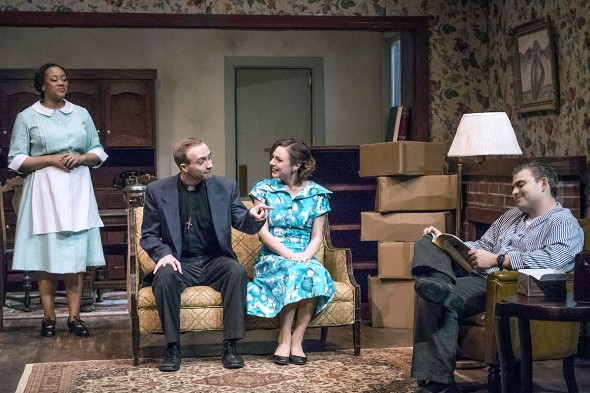Tensions over race rise in ‘Clybourne Park’

The racial circumstances in the first act of “Clybourne Park,” set in 1959, are reversed in the second act. Photo: Laura Horan
UIC Theatre’s “Clybourne Park”
7:30 p.m. Thursday, Friday, Saturday
2 p.m. today, Sunday
$11 UIC students, $14 UIC faculty and staff, $16 others
312-996-2939
By Eva Meier
Sometimes people look at the topics of gentrification and racism as topics that go together. But the technical definition of gentrification on its own is actually based more on the idea of economics and less on race.
The dual-act production of “Clybourne Park” gives the audience two parallel, yet incredibly different insights on how people deal with both of these politically sensitive and slightly uncomfortable topics. Jumping through 40 years of history, the play portrays the realities of how each subject has been addressed in the past and present day: awkwardly and precariously.
The first scene takes the audience to 1959, in the home of Bev and Russ, in the white neighborhood of Clybourne Park. Controversy brews when the neighborhood council finds out that the couple is considering selling their home to a black family.
Russ, the surly and severely-depressed man that he is, flies off the handle at his neighbor, Karl, and neighborhood pastor, Jim, for attempting to dissuade him and Bev from allowing the black family to move to the community.
Meanwhile, Francine and Albert, the only two black people in a room of borderline racists, are clumsily interrogated about their habits and everyday customs to prove how different whites and blacks are. The most “convincing” argument the overly persistent Karl comes up with is that black people don’t ski. Not as convincing as he thought it would be. But up until the end of Act One, absolutely no one outright addresses the elephant in the room: the race factor.
Act Two leaps over the next 40 years and brings the audience to the same house in what looks like an alternate universe. Gone were the furnishings, and there sat a group of eight diverse and feisty individuals, who paralleled the characters in the first act. Act Two, in short, was the modern-day recounting of the events in Act One. This time, the roles were switched.
Steve and Lindsay, a married white couple, were looking to purchase the home in Clybourne Park, which had belonged to Bev and Russ 40 years ago. However, as time progresses from 1959, the neighborhood had changed, as neighborhoods do. Over 40 years, Clybourne Park had become a predominantly black neighborhood and certain community members worried that having this new couple move into the area would kick start the gentrification process.
Tensions rise as the day goes on, and what starts out as a relatively calm encounter amongst the group turns into another aggressive screaming match, including racist “jokes,” insults and another sensitive situation addressing racism.
Clybourne Park is not a feel-good type of play. It’s controversial, loud, slightly inappropriate, and in my opinion, completely accurate. No one’s totally comfortable talking about race and gentrification, and the actors embrace those moments of uneasiness in stride.
A note of caution, however, is to be prepared for those screaming matches. The actors are whispering, talking and shouting over each other more often than not. Sitting in the second row, it unnerved me to be wrapped up in tension.
• Eva Meier is a freshman in English. Reach her at emeier2@uic.edu
